CaptiveAire C-ESP Installation Manual
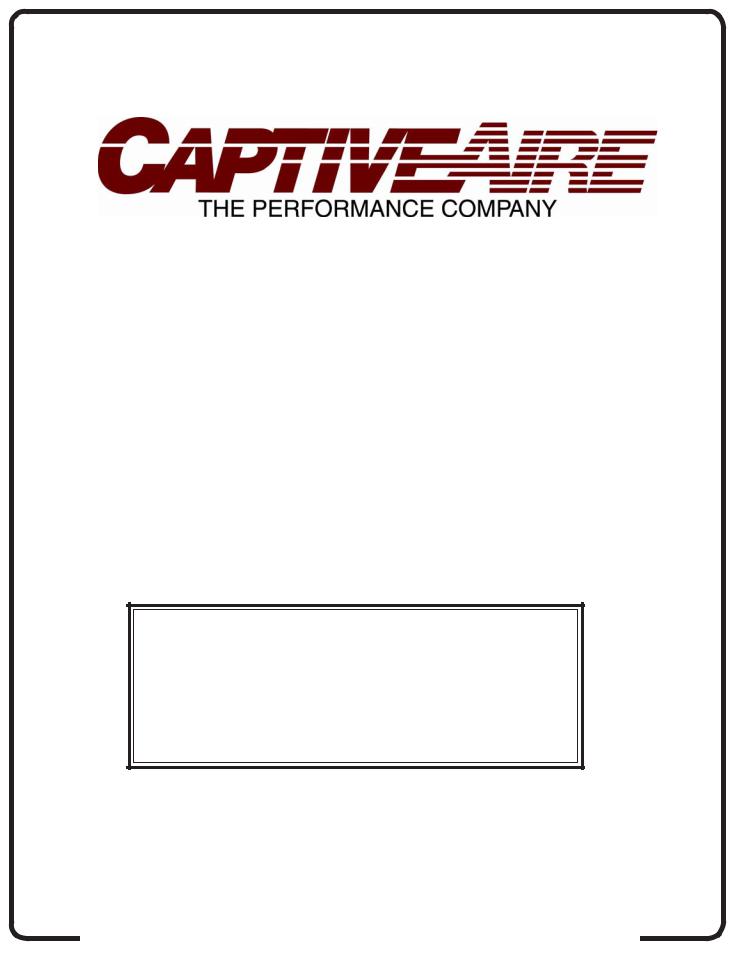
Effective Date: 11-04
TECHNICAL MANUAL
FOR
INSTALLATION, OPERATION
AND MAINTENANCE
OF
THE CAPTIVE-AIRE
MODEL "C-ESP" SERIES
POLLUTION CONTROL UNITS
WITH CGPC-6000-ESP COMMAND CENTER
WARNING
Improper installation, adjustment, alteration service or maintenance can cause property damage, injury or death. Read the installation, operation and maintenance instructions thoroughly before installing or servicing this equipment. Only trained and qualified service personnel should install or service this equipment.
CAPTIVE-AIRE SYSTEMS, INC.
360 NORTHBROOK DRIVE • YOUNGSVILLE, NC 27596 USA PHONE: 919-554-2414 • TOLL FREE: 866-784-6900 • FAX: 919-554-9374
email:webhome@captiveaire.com • www.captiveaire.com
TECHNICAL MANUAL
FOR
INSTALLATION, OPERATION
AND MAINTENANCE
OF
THE CAPTIVE-AIRE
MODEL “C-ESP” SERIES
POLLUTION CONTROL UNITS
WITH CGPC-6000-ESP COMMAND CENTER
Published by:
CAPTIVE-AIRE SYSTEMS, INC.
Youngsville, North Carolina 27596
U.S.A.
First Printing: November, 2004
© Copyright 2004, Captive-Aire Systems, Inc.
ALL RIGHTS RESERVED. NO PART OF THIS BOOK MAY BE REPRODUCED, STORED IN A RETRIEVAL SYSTEM, OR TRANSMITTED IN ANY FORM BY AN ELECTRONIC, MECHANICAL, PHOTOCOPYING, RECORDING MEANS OR OTHERWISE WITHOUT THE WRITTEN PERMISSION
OF CAPTIVE-AIRE SYSTEMS, INC. COPYRIGHT 2004.
The manufacturer reserves the right to modify the materials and specifications resulting from a continuing program of product improvement or the availability of new materials.
The Captive-Aire C-ESP Unit is designed and engineered by CAPTIVE-AIRE SYSTEMS, INC.
360 Northbrook Drive, Youngsville, NC 27596.

TABLE OF CONTENTS
INTRODUCTION ..................................................................................................... |
|
5 |
SPECIFICATIONS ............................................................................................... |
|
6-7 |
MODEL NUMBER EXPLANATION .......................................................................... |
|
8 |
TYPICAL INSTALLATION......................................................................................... |
|
9 |
SAMPLE C-ESP CONFIGURATIONS .............................................................. |
|
10-11 |
RECEIVING & INSTALLATION .............................................................................. |
|
12 |
EQUIPMENT LIFTING PROCEDURE ................................................................... |
|
13 |
ASSEMBLING C-ESP HOUSING ON UNITS SPLIT FOR SHIPMENT ............ |
14-15 |
|
SMOKE CONTROL .............................................................................................. |
|
16 |
C-ESP FIRE MODE ........................................................................................ |
|
17-18 |
DAILY OPERATION ......................................................................................... |
|
19-20 |
COMMAND CENTER INSTRUCTIONS .......................................................... |
|
21-24 |
TIME CLOCK OPERATION .................................................................................. |
|
25 |
DETERGENT PUMP OPERATION ................................................................. |
|
26-27 |
PREVENTIVE MAINTENANCE ........................................................................ |
|
28-29 |
CELL CONFIGURATION ....................................................................................... |
|
30 |
SPARE CELLS...................................................................................................... |
|
31 |
TROUBLE-SHOOTING – ESP SECTION....................................................... |
|
32-33 |
ODOR CONTROL .......................................................................................... |
|
34-37 |
EXHAUST FAN SECTION ............................................................................... |
|
38-39 |
RP DEVICE INITIAL START UP ............................................................................ |
|
40 |
TROUBLE-SHOOTING – GENERAL .............................................................. |
|
41-44 |
DETERGENT PUMP PARTS ................................................................................ |
|
45 |
CONTROL CABINET ............................................................................................ |
|
46 |
SUB PANEL .......................................................................................................... |
|
47 |
NAMEPLATE DATA ......................................................................................... |
|
48-49 |
TERMINAL VOLTAGES ................................................................................... |
|
50-51 |
WIRING DIAGRAM ................................................................................................ |
|
52 |
OPTIONAL CONNECTION INSTRUCTIONS......................................................... |
|
53 |
PLC STATUS LIGHTS ............................................................................................ |
|
54 |
DRAIN .................................................................................................................... |
|
55 |
SPRAY ODOR WIRING ......................................................................................... |
|
56 |
SPRAY ODOR TERMINAL VOLTAGES ................................................................. |
|
57 |
CGPC-6000-ESP SERIES CONTROL ............................................................. |
|
58,60 |
CGPC-6000-ESP COMPONENT SCHEDULE ................................................. |
|
59,61 |
POWER PACK PARTS.......................................................................................... |
|
62 |
CELL PARTS ......................................................................................................... |
|
63 |
MISCELLANEOUS PARTS .................................................................................... |
|
64 |
STARTUP INSTRUCTIONS ................................................................................... |
|
65 |
INSPECTION REPORT ......................................................................................... |
|
66 |
WARRANTY .................................................................................. |
Inside back cover |
|
4

INTRODUCTION
Air quality is a major concern in many large cities world wide, particularly in America. As a result, many commercial kitchens will require pollution control equipment in their exhaust systems to comply with the increasing demands of environmental control agencies. In addition, pollution control equipment is being used for other reasons such as kitchens in high-rise buildings to allow the exhaust to discharge out the side of the structure saving the cost of running the duct
up many floors to the roof.
Smoke pollution control, in kitchen exhaust systems, has typically been accomplished by any one of the following methods: gas fired incinerators, scrubbers, filtration units or electrostatic precipitators (C-ESP). Incinerators literally burn the pollutants and, while effective, can be very costly and hazardous to operate. Scrubbers consist of a water bath and extraction baffles to remove the pollutants and, though quite effective on grease removal, they typically require the addition of high efficiency filters to abate smoke below control agencies’ standards. Filtration units use a series of impingement filters to remove the pollutants and done properly can be quite effective on both smoke and grease.
The Captive-Aire pollution control unit, model C-ESP, can be manufactured with either electrostatic precipitation (C-ESP) or Filtration (C-TPF). Captive-Aire has manufactured commercial kitchen exhaust systems since the early 1980's. When initial cost is a greater concern the C-TPF unit is a sound alternative.
The C-ESP unit is available in several configurations, as illustrated on the following pages, ranging in capacity from 1000 to 32,000 CFM (472 to 15,102 L/s). Most models can include an optional exhaust fan and odor abatement equipment.
Basic Facts About Smoke
Smoke particles are extremely small and not visible to the human eye unless thousands of them are grouped together to form what we see as smoke. Individual particles are measured in units called microns and one micron equals 1/25,400 of an inch (1/64,516 of a cm).
Smoke generated by commercial cooking equipment has a particulate size of between 0.3 and 0.8 microns and it is these very small particles that smoke abatement equipment must remove from the air stream. The amount of smoke being discharged from a kitchen exhaust duct is measured in terms of its density, referred to as opacity - the degree to which emissions block light. A 100% opacity level would be solid black and 0% would be perfectly clear. Control agencies that have adopted smoke pollution ordinances are requiring an opacity level of no more than 20%, which is a very light blue smoke.
Typically, heavy smoke producing cooking such as charbroiling, creates an opacity level of 60% to 70%. Opacity readings are taken by the human eye by viewing the smoke being discharged and then assigning a percentage of opacity to what is seen. Though this method is quite subjective, it is the method practiced by control agency inspectors who are trained and certified in determining opacity percentages. Other more technical methods of determining opacity or particulate density are achieved through the use of opacity meters and
cascade impactors. This level of analysis is usually referred to as source testing. Control agencies occasionally require this type of analysis and if so, the testing is conducted by state certified contractors which can be quite costly and timeconsuming. The efficiency of a C-TPF is based on how well it reduces the opacity level of a given airstream.The CaptiveAire unit will reduce the opacity level below 20%, thereby meeting the requirements of environmental control agencies.
Basic Facts About Odor
Cooking odors (molecules) generated by the combustion of animal and vegetable matter result in an extremely complex mixture of reactive organic gases (ROG’s). A small percentage of these odors may be absorbed by the grease particles but the vast majority exist separately in the airstream. The ROG molecules are much too small to be removed by any type of filter and therefore, other methods must be used. There are several methods with which to manage the odor. One method is to use a media bed. The two most popular types of media bed are activated charcoal, which absorbs and retains the odor molecules, and the use of an odor-oxidant media (potassium permanganate) which oxidizes the molecules to solids and then retains them. The other method involves the use of a liquid delivered with a finely atomized spray. This spray performs a similar function to potassium permanganate in that it adsorbs or chemically neutralizes odors. This process has the benefit of the end user being able to adjust the amount of spray and thus the effectiveness and cost of the odor control.
The life of the media bed type of odor control is dependent upon several factors such as how much media is used, type of odor, amount of odor molecules, grease loading and air temperature. Typically, any of the above mentioned types of media can remove 85% - 90% of the molecules. Determining the efficiency of odor control can be very subjective, as testing is usually conducted by the human nose. More scientific testing is available through ROG analysis, but this involves considerable costs.
Grease Removal - The Important First Step
Grease particles are also measured in terms of microns and grease generated by commercial cooking equipment has a particulate size of 10 microns and up. Pollution control equipment is not limited to removing smoke particles, but will also remove a majority of the grease particles remaining in the airstream. Therefore, the grease extraction efficiency of the exhaust hood plays an important role in the operation and performance of pollution control equipment.
Removal of grease particles before they reach smoke and odor control equipment will significantly increase the smoke abatement efficiency and the life of the odor abatement media. It is highly recommended that a Captive-Aire Ventilator be used with the unit as it has a grease extraction efficiency of 95%. Other high efficiency exhaust hoods and standard filter type hoods may be used with the unit. Contact Captive-Aire Systems for details.
5

SPECIFICATIONS
General
Furnish one (1) Captive-Aire Pollution Control Unit model number C-ESP series as manufactured by Captive-Aire Systems, Inc. of Youngsville, North Carolina in accordance with the following:
The pollution control unit shall consist of a smoke control section, odor control section (optional) and an exhaust fan section (optional) all built on a common base as an integral unit. Smoke control shall be accomplished by electrostatic precipitation (ESP). The unit shall be ETL listed and labelled.
Smoke Control Section
The smoke control section shall contain one or more electrostatic precipitator (ESP) cells to remove smoke particles from the air stream to a level no higher than 20% opacity when operated in accordance with the operation and maintenance guidelines. The ESP cells shall be of a floating plate design to eliminate plate warpage during high heat operation. The cells shall be positioned on slide tracks so that they may be easily removed through a hinged cell access door(s). For ease of handling, individual cells shall weigh less than 54 lbs. There shall be removable, cleanable debris screens located immediately upstream of the ESP cells and a moisture separator immediately downstream. An electrical panel mounted on the unit shall contain the high voltage power pack assembly, safety disconnect switch, main disconnect switch, fuses and a magnetic starter for the exhaust fan when fan is included. The safety disconnect switch shall interface with the electrical panel access door such that when opened it will shut off service to the power pack(s) and ground them to drain the residual electrical charge from both the power pack(s) and ESP cells. The ESP cell access door shall interface with the electrical panel access door so that it cannot be opened without first opening the electrical panel access door. The high voltage power pack(s) shall be self-limiting type and shall be self contained. The electrical panel shall include indicating lights to monitor cell and transformer voltage. The main disconnect switch for the exhaust fan and control circuits shall lock the electrical panel access door closed when in the “on” position. The unit shall contain one or more wash manifold(s) with brass spray nozzles to wash the ESP cells with hot detergent injected water each time the exhaust fan is shut off.
Fire Detection
A thermostat, set at 250o F, shall also be located in the filter section to shut down the exhaust fan in the event of a fire.

 Optional Fire Damper for use in Canada
Optional Fire Damper for use in Canada
The unit shall include a UL listed fire damper, with a 280o F fusible link, located downstream of the filters to prevent passage of fire to the duct downstream of the unit
Odor Control Options
 Media bed of 50/50 Blend Potassium Permanganate and Carbon Blend
Media bed of 50/50 Blend Potassium Permanganate and Carbon Blend
The unit shall be provided with odor control utilizing a media bed of 50% potassium permanganate 50% carbon blend. The odor removal media shall be housed in slide out reusable steel modules. There shall be a 30% pleated media after filter lo-
cated immediately downstream of the odor control media. Replaceable filters shall be mounted in filter slide tracks to prevent air bypass around the ends of the installed filter bank. The odor control media and after filters shall be removable through side access doors with lift and turn latches.

 Spray Odor Control
Spray Odor Control
The unit shall be provided with a spray odor control system utilizing an odor neutralizer chemical. The odor spray control cabinet shall be mounted on the side of the unit and shall contain a liquid spray compressor piped to the spray nozzle in the fan plenum, adjustable delay timers with fuse protected circuitry factory wired to the unit electrical panel. The cabinet shall include one 5 gallon container of Formula GS710 Odor Neutralizer. The cabinet shall contain a heater to prevent freezing of the odor neutralizer.
Exhaust Fan Options

 Exhaust Fan (Standard Centrifugal Fan)
Exhaust Fan (Standard Centrifugal Fan)
The unit shall include a centrifugal exhaust fan. The exhaust fan shall be an upblast arrangement with a non-overloading wheel. The motor, drives, bearings and fan mounting base shall be located out of the exhaust air stream as required by the IMC (International Mechanical Code) and NFPA-96. The fan shall be ETL Listed and shall be AMCA certified and bear theAMCAseal for performance. The fan housing shall be constructed of heavy gauge steel. The fan bearings shall be heavy duty pillow block type rigidly mounted on heavy structural steel supports. The motor shall be ODP. The fan shall include a disconnect switch.

 Exhaust Fan (Optional Tubular Fan)
Exhaust Fan (Optional Tubular Fan)
The unit shall include a tubular centrifugal exhaust fan. The exhaust fan shall be an arrangement #10 with a non-overload- ing BI,AF wheel. The motor, drives, bearings and fan mounting base shall be located out of the exhaust air stream as required by the IMC (International Mechanical Code) and NFPA-96. The fan shall be AMCA certified and bear the AMCA seal for performance. The fan housing shall be constructed of heavy gauge steel. The fan bearings shall be heavy duty rigidly mounted on heavy structural steel supports. The motor shall be ODP three phase mounted on a common base with the fan and shall be pre-wired to the electrical cabinet located on the unit. The electrical cabinet shall include a disconnect switch, motor starter, overloads and fuses. The factory provided drive assembly shall be adjustable pitch on 5 HP and smaller and fixed pitch on 7.5 HP and larger. It shall also be sized for a minimum 1.5 service factor.After final system balancing, fixed pitch sheaves shall be provided and installed by the air balancing contractor to provide proper flow at actual installed conditions.
Unit Construction
The unit housing shall be constructed of a minimum of 16 gauge G90 bright galvanized steel. The perimeter base shall be 12 gauge formed channel with lifting lugs at each corner and along the length as required. The internal housing shall be externally welded liquid tight for compliance to the International Mechanical Code and NFPA-96 grease duct construction requirements.
6
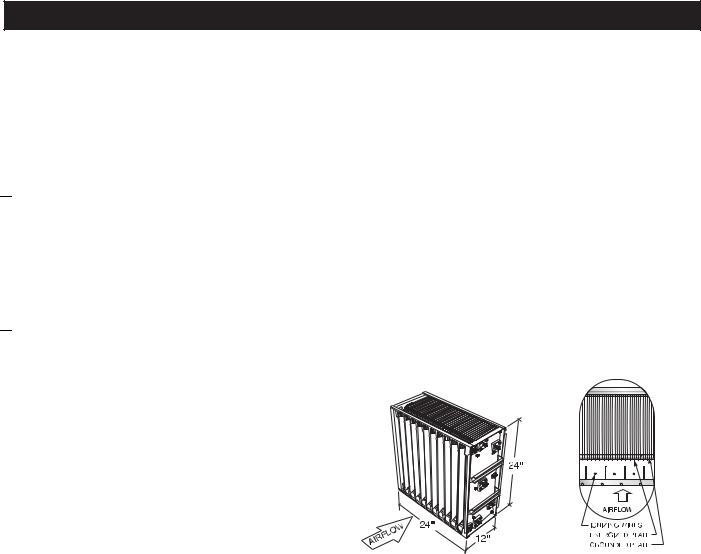
SPECIFICATIONS
Fire Extinguishing System Options
Specifier Note: NFPA-96 requires a fire extinguishing system for protection of the smoke and odor control sections and protection of the duct down stream of any filters or dampers. Not all authorities having jurisdiction require protection. Check with your AHJ. If required, specify one of the following systems.

 Wet chemical system
Wet chemical system
Provide a complete factory mounted Ansul wet chemical fire extinguishing system, including nozzles piping and detection runs. Pipe penetrating the unit cabinet shall use a UL listed fitting. System shall be installed in accordance with the systems listing and NFPA-96. The Ansul Automan cabinet shall be mounted on the side of the unit for easy access, certification and service.

 Water spray sprinkler fire system
Water spray sprinkler fire system
Specifier Note: Units that are located indoors may be factory pre-piped for a wet pipe building sprinkler system.
Provide a pre-piped water spray fire system installed in accordance with NFPA-96. The unit shall be piped with one pendent type sprinkler nozzle located in the smoke control section, one in the odor control section, if equipped with 50/50 media bed, and one in the exhaust fan section for interconnection to the building sprinkler system by the appropriate trades. Pipe penetrating the unit cabinet shall use a UL listed fitting. Nozzles shall be the bulb type rated at 325o F.
Check Out and Demonstration
Upon completion of installation, the entire pollution control system, including the kitchen exhaust hoods, shall be commissioned by factory certified personnel. Start-up shall include checking all filters, filter monitoring station, odor control and exhaust fan. The appropriate maintenance personnel shall be given a technical manual and a complete demonstration of the system, including operation and maintenance procedures. Upon completion of the commissioning, a detailed start-up report shall be made available to the architect and owner certifying proper system operation. Changes required in fan drive components shall be performed by the air balancing contractor under the direction of the factory certified person(s) performing the start-up.
ELECTROSTATIC CELL
ISOMETRIC VIEW |
SIDE VIEW |
7
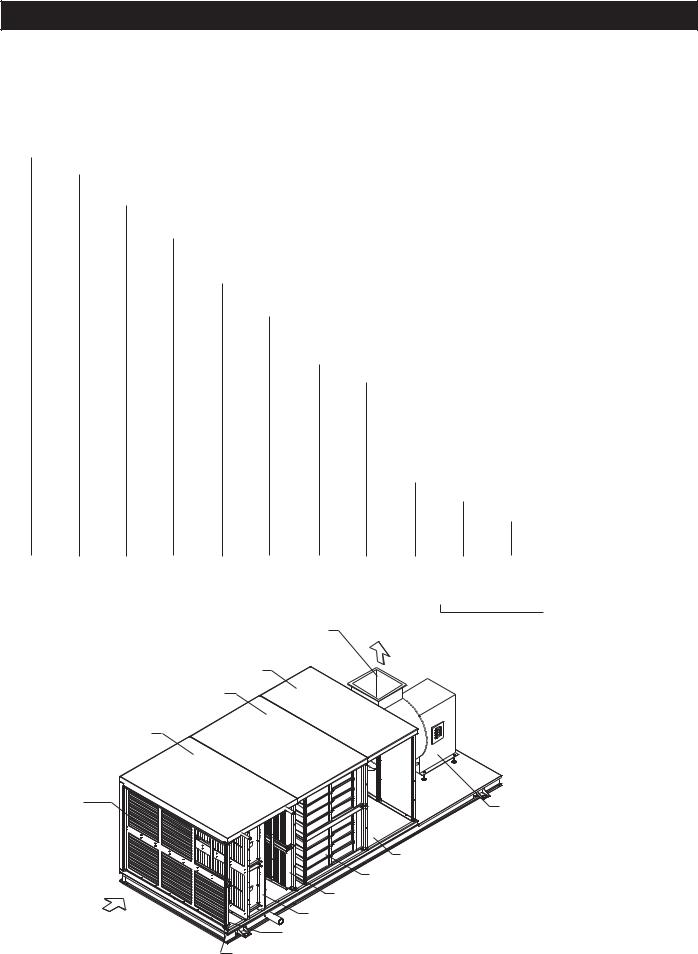
MODEL NUMBER EXPLANATION
The assigned model number of a C-ESP unit will indicate the number of Cell Banks and if it has spray odor control, single or double pass odor control, if it has an exhaust fan plus other data. The following example shows the make-up of a model number.
The model number of your C-ESP unit along with other data can be found on the nameplate which is attached to the electrical control panel on the unit. Refer to page 49.
Standard Prefix Series of C-ESP System (Remote Smoke Pollution Control)
1 ESP = Single Pass Electrostatic Cells
2 ESP = Double Pass Electrostatic Cells
ESP Cell Configuration (WxH) - 1x1, 2x1, 3x1, 2x2, 3x2, 4x2, 3x3, 4x3, 3x4, 4x4
Nominal FPM ESP Cell Velocity
250 FPM = Heavy and Extra Heavy Duty Cooking,
500 FPM = Light and Medium Duty Cooking
Number of Wash Banks
DW = Double Wash, Blank = Single Wash
Odor Control Option
SO = Single Pass Odor Control
DO = Double Pass Odor Control
SPO =Spray Odor
Total CFM
Exhaust Fan Option
EFS = Exhaust Fan, unhoused, spring isolated
EFN = Exhaust Fan, unhoused, not spring isolated
EFHS = Exhaust Fan, housed, spring isolated
EFHN = Exhaust Fan, housed, not spring isolated
(BLANK) = No Exhaust Fan
Fan Type - C = Centrifual, T = Tubular
Fan Size
Fan Motor H.P.
|
|
|
|
|
|
|
|
|
|
|
|
|
|
Hand - R = Right Hand |
|
|
|
|
|
|
|
|
|
|
|
|
|
|
|
|
|
|
|
|
|
|
|
|
|
|
|
|
|
L = Left Hand |
|
|
|
|
|
|
|
|
|
|
|
|
|
|
|
C |
1ESP - 3x2 - |
500 |
- DW |
- DO |
- 9000 |
- EFN |
- C |
- 300 - |
5 - |
R |
||||
Block |
1 |
2 |
3 |
4 |
5 |
6 |
|
7 |
8 |
9 |
10 |
|
11 |
|
|
|
|
|
|
|
|
|
|
|
|
|
|
|
|
All Blank, if no exhaust fan
Exhaust Fan Section (EFN)
Plenum Section
Optional Spray Odor (SPO)
Odor Control (optional)
Section (SO, DO)
ESP section
ESP Cell |
Fan Type (Centrifual |
|
Configuration |
||
or Tubular) |
||
(3 x 2) |
||
|
||
|
Plenum Access |
|
|
Odor Media (DO shown) |
|
|
Moisture Separator |
|
Inlet Airflow |
ESP Cells Single Pass (1ESP) |
|
Debris Screen |
||
|
||
|
Hand (Right Hand Access) |
|
|
Access Side, R or L, Determined by Facing |
|
|
Unit with Inlet Airflow to back of head |
8
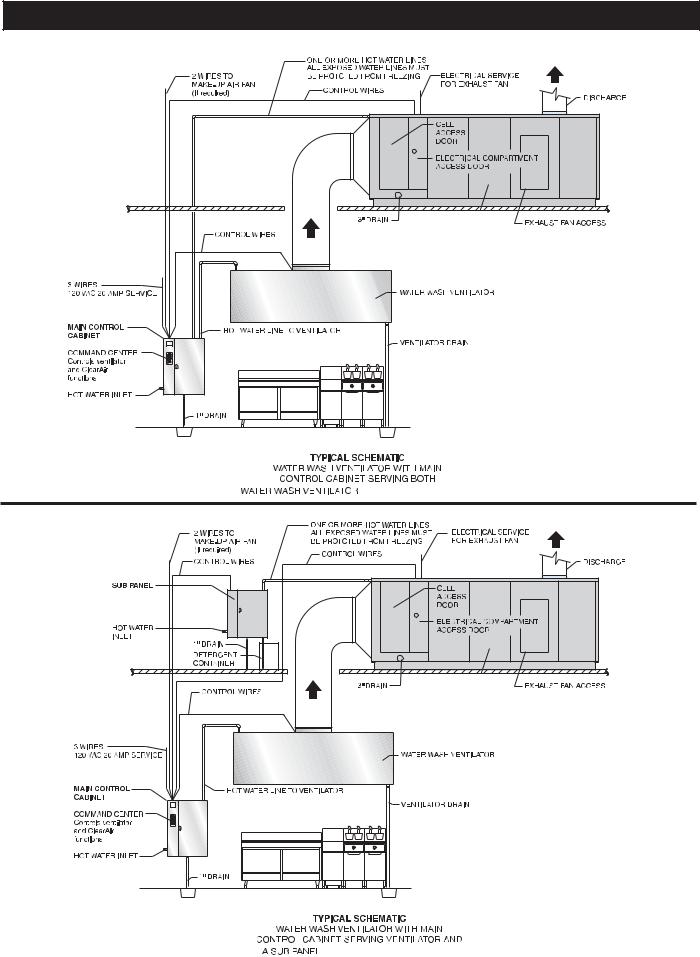
TYPICAL INSTALLATION
9
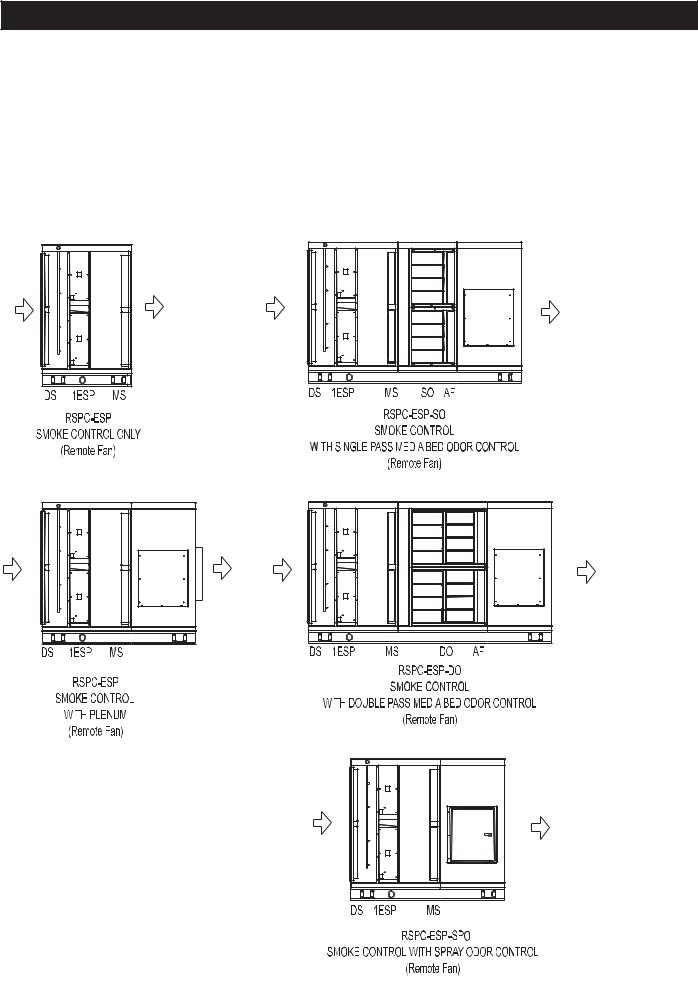
SAMPLE C-ESP CONFIGURATIONS
The Captive-Aire unit is available in sizes ranging in capacity |
KEY |
|
|
|
|
|
|
|
|
|
|
|
|
||||||||
from 1000 to 32,000 CFM (472 to 15,102 L/s). Each unit is |
|
|
|
|
|
|
|
|
|
|
|
|
|||||||||
|
|
|
|
|
|
|
|
|
|
|
|
||||||||||
equipped with Three Phase Filters for smoke control, and |
1ESP |
= |
|
Single Pass Electro- |
EFHS |
= |
Exhaust Fan, housed, |
||||||||||||||
may include an exhaust fan, odor abatement equipment and |
|
|
|
|
|
|
static Cells |
|
|
spring isolated |
|||||||||||
Quencher System, or Ansul System as an option. The fol- |
2ESP |
= |
|
Double Pass Electro- |
EFHN |
= Exhaust Fan, housed, not |
|||||||||||||||
lowing illustrations are examples of the most common con- |
|
|
|
|
|
|
static Cells |
|
|
spring isolated |
|||||||||||
figurations. |
AF |
= |
|
30% After Filter |
FD |
= |
Optional Curtain Fire |
||||||||||||||
|
|
|
|
|
|
|
|
DO |
= |
|
Double Pass Odor |
|
|
Damper |
|||||||
|
|
|
|
|
|
|
|
|
|
|
|
|
|
Kor48/Carbon blend |
MS |
= |
Moisture Separator |
||||
|
|
|
|
|
|
|
|
DS |
= |
|
Debris Screen |
SO |
= |
Single Pass Odor |
|||||||
|
|
|
|
|
|
|
|
EFS |
= |
|
Exhaust Fan, unhoused, |
|
|
Kor48/Carbon blend |
|||||||
|
|
|
|
|
|
|
|
|
|
|
|
|
|
spring isolated |
SPO |
= |
Spray Odor Cabinet |
||||
|
|
|
|
|
|
|
|
EFN |
= |
|
Exhaust Fan, unhoused, |
|
|
|
|
||||||
|
|
|
|
|
|
|
|
|
|
|
|
|
|
not spring isolated |
|
|
|
|
|||
|
|
|
|
|
|
|
|
|
|
|
|
|
|
|
|
|
|
|
|
|
|
|
|
|
|
|
|
|
|
|
|
|
|
|
|
|
|
|
|
|
|
|
|
|
|
|
|
|
|
|
|
|
|
|
|
|
|
|
|
|
|
|
|
|
|
|
|
|
|
|
|
|
|
|
|
|
|
|
|
|
|
|
|
|
|
|
|
|
|
|
|
|
|
|
|
|
|
|
|
|
|
|
|
|
|
|
|
|
|
|
|
|
|
|
|
|
|
|
|
|
|
|
|
|
|
|
|
|
|
|
|
|
|
|
|
|
|
|
|
|
|
|
|
|
|
|
|
|
|
|
|
|
|
|
|
|
|
|
|
|
|
|
|
|
|
|
|
|
|
|
|
|
|
|
|
|
|
|
|
|
|
|
|
|
|
|
|
|
|
|
|
|
|
|
|
|
|
|
|
|
|
|
|
|
|
|
|
|
|
|
|
|
|
|
|
|
|
|
|
|
|
|
|
|
|
|
|
|
|
|
|
|
|
|
|
|
|
|
|
|
|
|
|
|
|
|
|
|
|
|
|
|
|
|
|
|
|
|
|
|
|
|
|
|
|
|
|
|
|
|
|
|
|
|
|
|
|
|
|
|
|
|
|
|
|
|
|
|
|
|
|
|
|
|
|
|
|
|
|
|
|
|
|
|
|
|
|
|
|
|
|
|
|
|
|
|
|
|
|
|
|
|
|
|
|
|
|
|
|
|
|
|
|
|
|
|
|
|
|
|
|
|
|
|
|
|
|
|
|
|
|
|
|
|
|
|
|
|
|
|
|
|
|
|
|
|
|
|
|
|
|
|
|
10
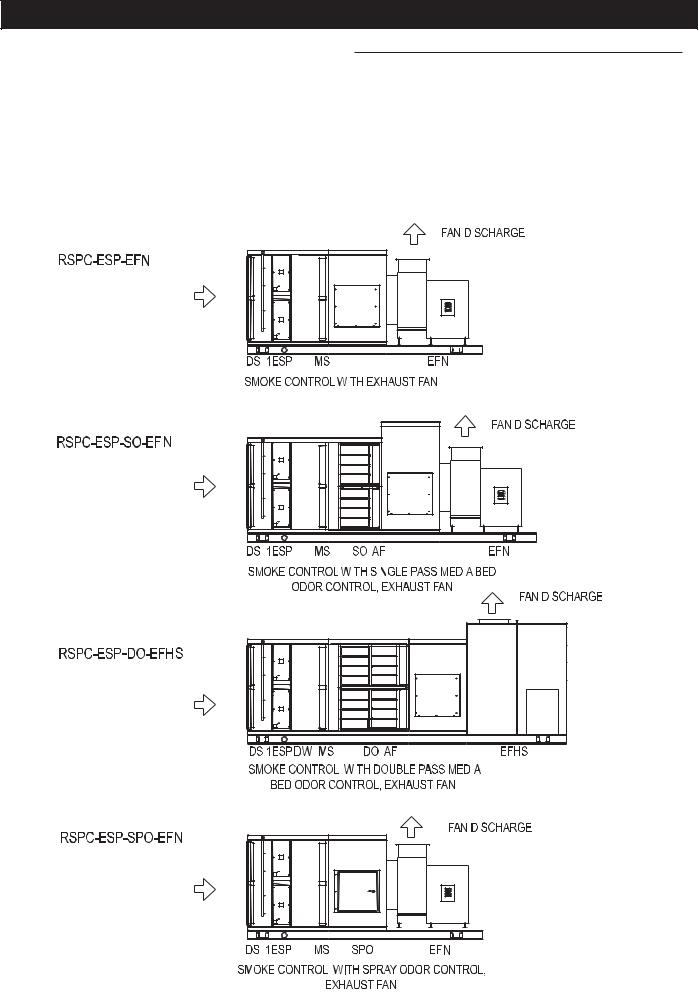
SAMPLE C-ESP CONFIGURATIONS
KEY
|
|
|
|
|
|
|
|
1ESP = |
Single Pass Electro- |
EFN |
= |
Exhaust Fan, unhoused, |
||||||
|
|
|
|
|
|
|
|
|
|
|
static Cells |
|
|
|
not spring isolated |
|||
|
|
|
|
|
|
|
|
2ESP = |
Double Pass Electro- |
EFHS = |
Exhaust Fan, housed, |
|||||||
|
|
|
|
|
|
|
|
|
|
|
static Cells |
|
|
|
spring isolated |
|||
|
|
|
|
|
|
|
|
DO |
= |
Double Pass Odor |
EFHN = |
Exhaust Fan, housed, |
||||||
|
|
|
|
|
|
|
|
|
|
|
Kor48/Carbon blend |
|
|
|
not spring isolated |
|||
|
|
|
|
|
|
|
|
DS |
= |
Debris Screen |
FD |
= |
Optional Curtain Fire |
|||||
|
|
|
|
|
|
|
|
DW |
= |
Dual Wash (2nd wash |
|
|
|
Damper |
||||
|
|
|
|
|
|
|
|
|
|
|
manifold) |
MS |
= |
Moisture Separator |
||||
|
|
|
|
|
|
|
|
EFS |
= |
Exhaust Fan, unhoused, |
SO |
= |
Single Pass Odor |
|||||
|
|
|
|
|
|
|
|
|
|
|
spring isolated |
|
|
|
Kor48/Carbon blend |
|||
|
|
|
|
|
|
|
|
|
|
|
|
|
|
|
SPO |
= |
Spray Odor Cabinet |
|
|
|
|
|
|
|
|
|
|
|
|
|
|
|
|
|
|
|
|
|
|
|
|
|
|
|
|
|
|
|
|
|
|
|
|
|
|
|
|
|
|
|
|
|
|
|
|
|
|
|
|
|
|
|
|
|
|
|
|
|
|
|
|
|
|
|
|
|
|
|
|
|
|
|
|
|
|
|
|
|
|
|
|
|
|
|
|
|
|
|
|
|
|
|
|
|
|
|
|
|
|
|
|
|
|
|
|
|
|
|
|
|
|
|
|
|
|
|
|
|
|
|
|
|
|
|
|
|
|
|
|
|
|
|
|
|
|
|
|
|
|
|
|
|
|
|
|
|
|
|
|
|
|
|
|
|
|
|
|
|
|
|
|
|
|
|
|
|
|
|
|
|
|
|
|
|
|
|
|
|
|
|
|
|
|
|
|
|
|
|
|
|
|
|
|
|
|
|
|
|
|
|
|
|
|
|
|
|
|
|
|
|
|
|
|
|
|
|
|
|
|
|
|
|
|
|
|
|
|
|
|
|
|
|
|
|
|
|
|
|
|
|
|
|
|
|
|
|
|
|
|
|
|
|
|
|
|
|
|
|
|
|
|
|
|
|
|
|
|
|
|
|
|
|
|
|
|
|
|
|
|
|
|
|
|
|
|
|
|
|
|
|
|
|
|
|
|
|
|
|
|
|
|
|
|
|
|
|
|
|
|
|
|
|
|
|
|
|
|
|
|
|
|
|
|
|
|
|
|
|
|
|
|
|
|
|
|
|
|
|
|
|
|
|
|
|
|
|
|
|
|
|
|
|
|
|
|
|
|
|
|
|
|
|
|
|
|
|
|
|
|
|
|
|
|
|
|
|
|
|
|
|
|
|
|
|
|
|
|
|
|
|
|
|
|
|
|
|
|
|
|
|
|
|
|
|
|
|
|
|
|
|
|
|
|
|
|
|
11

RECEIVING & INSTALLATION
RECEIVING
Most C-ESP units are shipped in one piece. However, some units, because of size or special jobsite conditions, may be shipped in multiple sections. Follow the instructions provided with the unit to join sections back together. If the unit includes media bed odor control, the KOR48/carbon odor control media is packaged separately. Verify against the shipping documents that you have received all items and note any shipping damage, obvious or hidden, to your carrier and on your Bill of Lading. If damage is found, immediately file a claim with the transport company. All units are thoroughly inspected and fully operation tested at the factory prior to shipment.
Verify that the electrical and air flow ratings on the unit nameplate agrees with jobsite requirements. If a contradiction arises notify the factory prior to proceeding with installation.
SAFETY CONSIDERATIONS
Installing and servicing the C-ESP unit can be hazardous due to the presence of electrical components. Only trained and qualified service personnel should install or service this equipment.
Untrained personnel can perform basic maintenance, such as cleaning and replacing filters. All other operations should be performed by trained service personnel. When installing or servicing, observe precautions in literature and on tags and labels attached to unit.
Follow all safety codes. Wear safety glasses and work gloves. Use quenching cloth for brazing operations. Have fire extinguisher available. Read these instructions thoroughly.
WARNING
Before installing or servicing system, always turn off main power to system. There may be more than one disconnect switch. Electrical shock can cause personal injury or death.
RIGGING
All units are provided with a minimum of four (4) lifting points for rigging attachment. WARNING: Use all lifting points provided. (Refer to Page 13) Spreader bars are mandatory to prevent contact and damage to the unit by lifting hooks, straps, cables, or chains. Consult the mechanical or structural engineer before moving the unit across the roof deck.
INSTALLATION CODES
This unit requires external plumbing and electrical connections to be made in the field. It is recommended that the Authority Having Jurisdiction (AHJ) be consulted regarding local codes and installation procedures. Captive-Aire Systems is not responsible for obtaining necessary approvals and permits which may be required for installation, nor is it responsible for verifying that the unit has been installed in accordance with national, state, and local codes. In the absence of locally adopted codes use the current editions of the National Electrical Code and the Uniform Mechanical Code. Connections of the exhaust duct to the inlet and outlet of the C-ESP unit must be fully welded to comply with NFPA-96.
INSTALLATION PRECAUTIONS
1.The services of qualified contractors are essential for safe and proper installation of this equipment.
2.The air volumes and external static pressures that are listed on the unit are for the middle of the operating range of the filters. The initial air volume should be at least 10% higher than the listed CFM. As the filters load up the air volume will drop. This is inherent to this type of unit. If the unit is set up at or below the design CFM, as the filters load up, the kitchen hood may experience smoke loss problems. Please consult the factory if you have questions.
3.The unit is designed for installation on a level surface.
4.When installed in an enclosed space a fire rated enclosure may be required for the unit and associated duct work. Consult the Authority Having Jurisdiction.
5. Consult the Authority Having Jurisdiction regarding requirements covering the point of termination of the exhaust outlet of this unit. Minimum distances must usually be maintained between the exhaust outlet and any outside air intakes and/or adjacent structures or property lines.
6.Do not apply power to the unit until all electrical connections have been made and a pre-start-up preliminary inspection has been completed.
7.Allow a minimum of 36 inches clearance in front of the filter access door and electrical compartment door for service and routine maintenance per NEC.
SHORT TERM STORAGE
Units that include media bed odor control are provided with KOR48/carbon media which is shipped separate from the unit. KOR48/carbon media must be stored in a dry place with less than 95% relative humidity.
EXHAUST FAN RECEIVING AND STORAGE
If the unit is equipped with an exhaust fan it must be relubricated as soon as it arrives. To prevent corrosion all bearings should receive grease and be rotated the first of every month. Rotate the wheel several revolutions every three to five days to keep a coating of grease on all internal bearing parts. Turn the wheel by hand while greasing bearings. A clean 1/16" bead of grease must appear on each side of each bearing. Refer to specific bearing lubricating instructions on the fan. Also, refer to bearing lubricating instructions found in the exhaust fan section of this manual.
Bearings which are to be stored or idle for an extended period of time should be wrapped in a neutral grease-proof paper, foil, or plastic film. Compounds can be recommended by the bearing manufacturer to provide protection for several months to several years.
After long-term storage, grease should be purged from the bearings and fresh grease injected prior to start-up.
12
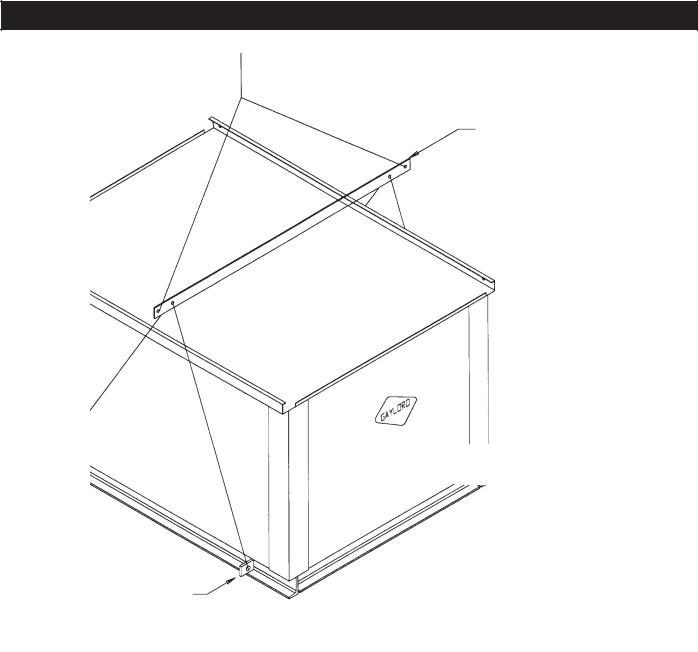
EQUIPMENT LIFTING PROCEDURE
SPREADER
BAR
LIFTING
LUGS
1.All units are provided with a minimum of four lifting points for rigging attachment. All lifting points must be used.
2.Spreader bars are mandatory to prevent contact and damage to the unit by lifting hooks, straps, cables or chains.
13
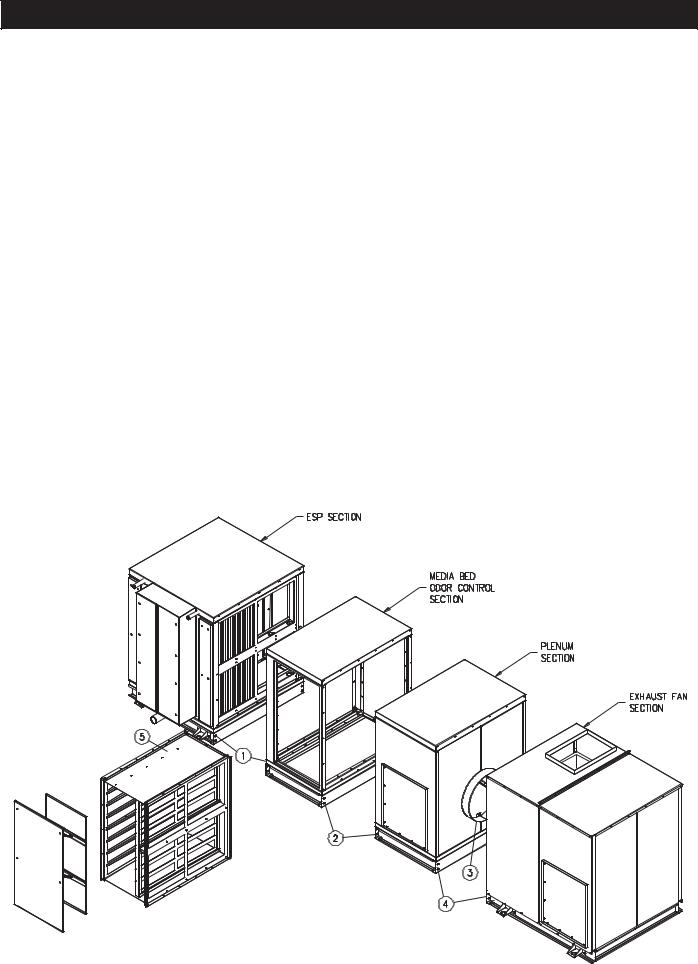
HOUSING ASSEMBLY INSTRUCTIONS
Typically, C-ESP units are shipped as one piece. Sometimes for building accessibilty reasons a unit may be shipped in multiple pieces. If this is the case, refer to the instruction below and on page 15.
1. Attach "ESP Section" to "Media Bed Odor Control Section":
Bolt "Media Bed Odor Control Section" and "ESP Section" bases together on outside of unit, using 3/4" holes. Tek screw walls and roofs together, using 3/16" holes. Continuously weld: floor, wall, and roof seams from inside of unit.
2. Attach "Media Bed Odor Control Section" to "Plenum Section":
Bolt "Media Bed Odor Control Section" and "Plenum Section" bases together on outside, using 3/4" holes. From inside plenum, tek screw walls and roofs together, using 3/16" holes. Continuously weld: floor, wall, and roof seams from inside of unit.
3. Attach Fan Inlet to "Plenum Section" outlet:
Push "Exhaust Fan Section" about 7 inches from "Plenum Section". Tek screw & caulk fan duradyne to plenum interconnect ring, at 5 inch intervals (minimum). Duradyne is pre-attached to fan inlet side.
4. Attach "Plenum Section" to "Exhaust Fan Section":
Bolt "Plenum Section" and "Exhaust Fan Section" bases together on outside, using 3/4" holes. From inside of plenum, tek screw walls and roofs together, using 3/16" holes. Continuously weld floor seam from inside plenum. "Exhaust Fan Section" walls and roof to remain removable for exhaust fan replacement, tek screw and bolt only.
5. Assemble "Media Bed Odor Control Section":
Refer to "Media Bed Odor Control Section Assembly Instructions" drawing.
6. Reconnect Electrical to Exhaust Fan
14
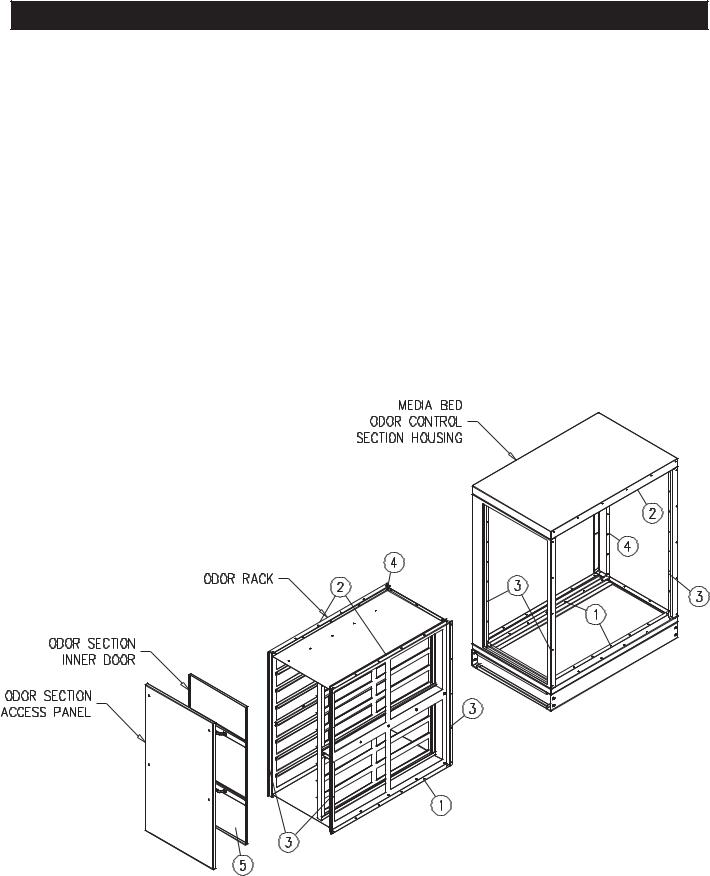
MEDIA BED ODOR CONTROL SECTION ASSEMBLY INSTRUCTIONS
NOTE: Assemble this section, only after the rest of the unit has been assembled.
1.Slide odor rack into unit through door opening. Tek screw rack to floor rails, using 3/16" holes.
2.Tek screw upper rack to both sides of roof rails.
3.Tek screw first 3 sides to mouning rails from outside of the unit.
4.Attach fourth side by entering odor rack to reach screw holes.
5.Attach odor section inner door, flip latches to secure.
15
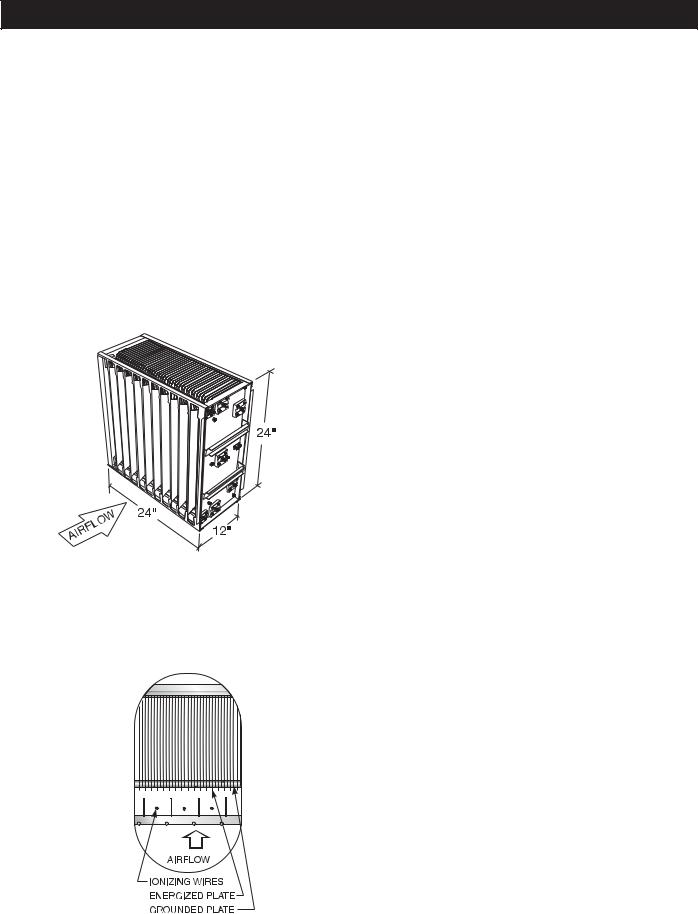
SMOKE CONTROL
Principle of Operation
The Captive-Aire Pollution Control Unit removes smoke particles by electrostatic precipitation. The principle of operation of electrostatic precipitation is actually quite basic. The electrostatic cell is made up of a series of aluminum plates spaced approximately 1/4” (6.35mm) apart and the number of cells used is determined by the air volume and the type of cooking equipment involved. Every other plate is energized with 5000 volts of D.C. power and the alternating plates are grounded. At the entry point of the cell is a series of thin wires spaced approximately 4” (101.60mm) apart. These wires, referred to as ionizing wires, are energized with 10,000 volts D.C. and as the smoke particles enter the cell and pass over the wires they receive a positive charge. As the charged particles continue through the cell, the positive plate repels them and the negative or grounded plate attracts them. Thus, the smoke particles are collected on the negative plates. The action is efficient, safe and simple.
ISOMETRIC VIEW
SIDE VIEW
ELECTROSTATIC CELL
Wash Cycle
All Captive-Aire units include, as standard equipment, an internal washdown system and control cabinet which when activated washes the unit with hot detergent injected water to remove the daily accumulation of smoke and grease particles. The washdown system and contols are interfaced with the Captive-Aire Water Wash Ventilator. There are two possible arrangements of controls for the operation of the Ventilator and the C-ESP Unit as illustrated on page 9. In the first arrangement, the Control Cabinet in the kitchen serves both the Ventilator and the C-ESP Unit. The hot water solenoid valves and detergent pump and container for both the Ventilator and C-ESP Unit are located in this cabinet.In the second arrangement there is a Control Cabinet for the ventilator electrically interfaced with a Sub Panel that serves the C-ESP Unit. The hot water solenoid valves and detergent pump for the C-ESP Unit are housed in the Sub Panel and the detergent container is located below or next to the panel. The detergent pump and container for the Ventilator are both housed in the main Control Cabinet located in the kitchen. In both arrangements the Exhaust Fan, ESP, Wash Cycles and Fire Cycle Functions are controlled by the Ventilator Control Cabinet. The difference between the two is the location of the plumbing components.
Fire Cycle
In the event of a fire, a 250o F. thermostat, mounted in the airstream, will activate shutting off the exhaust fan and ESP cells, and turning on the water sprays within the C-ESP Unit. The fire cycle of the water wash ventilator will also activate at this time. The water will run continually until the thermostat cools below 250o F, and then run for another 2 minutes.At the conclusion of this cool down cycle the exhaust fan may be started by pushing "Start Fan".
16
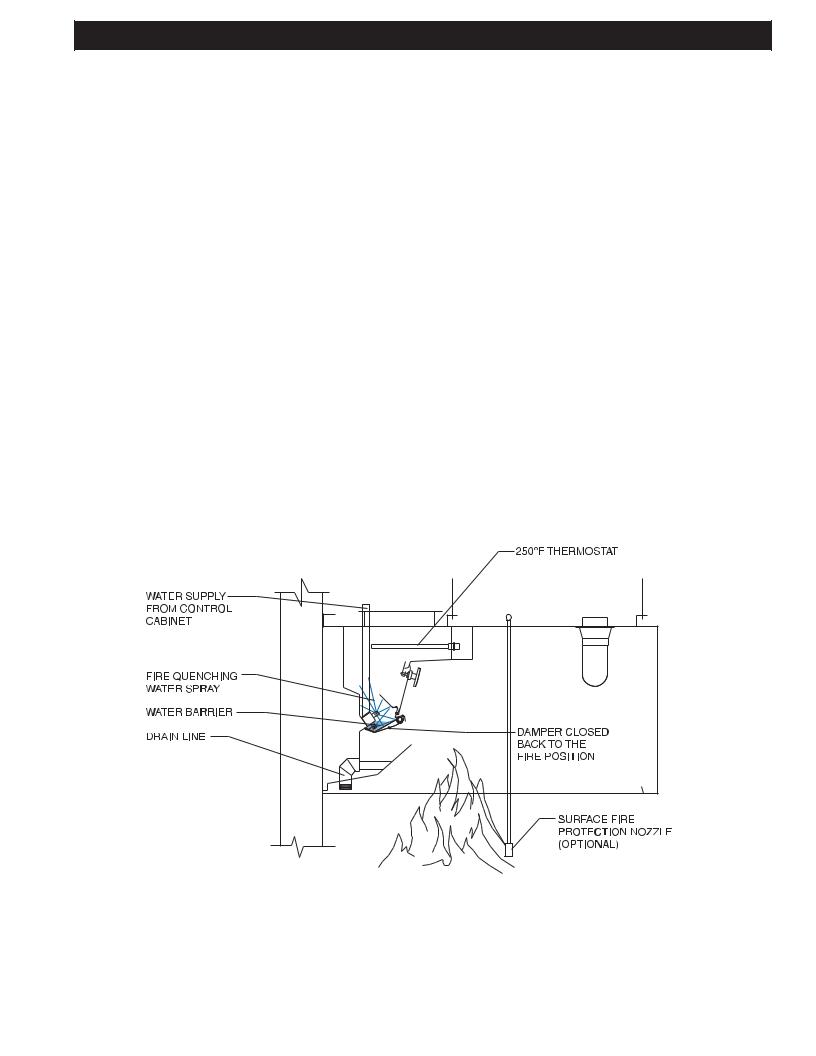
C-ESP FIRE MODE
INTERNALFIREMODE
Automatic internal fire protection is accomplished by the action of the thermostat(s), which is located in the filter section of the C-ESP. When the temperature of the conveying airstream, which must pass over the thermostats, reaches 250°F, the system is activated, and the following occurs:
1.The damper begins closing back to the fire position, on a Captive-Aire Ventilator, if so equipped, position 3 as shown in Fig.4—stopping the combustion-supporting, natural draft through the ventilator and creating a fire barrier to contain the fire in the kitchen.
2.The exhaust fan is shut off. The supply fan is also shut off.
3.Fire-smothering water spray is released into the interior of the C-ESP through the spray nozzles.
4.The digital display reads "Fire In Hood, Fan Off, Wash On" for approximately 5 seconds.
5.Then the digital display reads "Fire In Hood, Damper Closing" for approximately 5 seconds.
6.Then the digital display reads "Fire In Hood, Notify Fire Department". This display stays on until the thermostat cools down below 250°F.
CAUTION:
In case of severe fire the thermostats located in the filter section will activate. As a precautionary measure, it is recommended that the thermostats be replaced.
7.A red light on the Command Center illuminates.
8.If the Command Center is intertied with a building alarm or monitoring system, a fire signal would be sent to that system.
9.Upon cooling of the thermostat below 250oF, the Cool Down Cycle starts. The water continues to spray during the Cool Down Cycle (2 minutes). The damper moves to the exhaust position, on a Captive-Aire Ventilator, if so equipped.
10.While in the cool down cycle the digital display reads "Cool Down Cycle, xxx sec. to end". xxx is the countdown in seconds until the wash turns off.
11.At the end of the cool down cycle the water turns off and the digital display reads "Fan Off 12:00 (actual time), Start Fan>F1". The damper closes to the wash position in a Captive-Aire Ventilator, if so equipped.
NOTE: The water may be shut off prior to the end of the 2 minute cool down cycle by pushing the “Exit” button on the CGPC-6000 Command Center. After the water has shut off, the damper remains in the wash position on a Captive-Aire Ventilator, if so equipped, until the “Start Fan” button is pushed.
FIRE CYCLE
Captive-Aire Ventilator
17
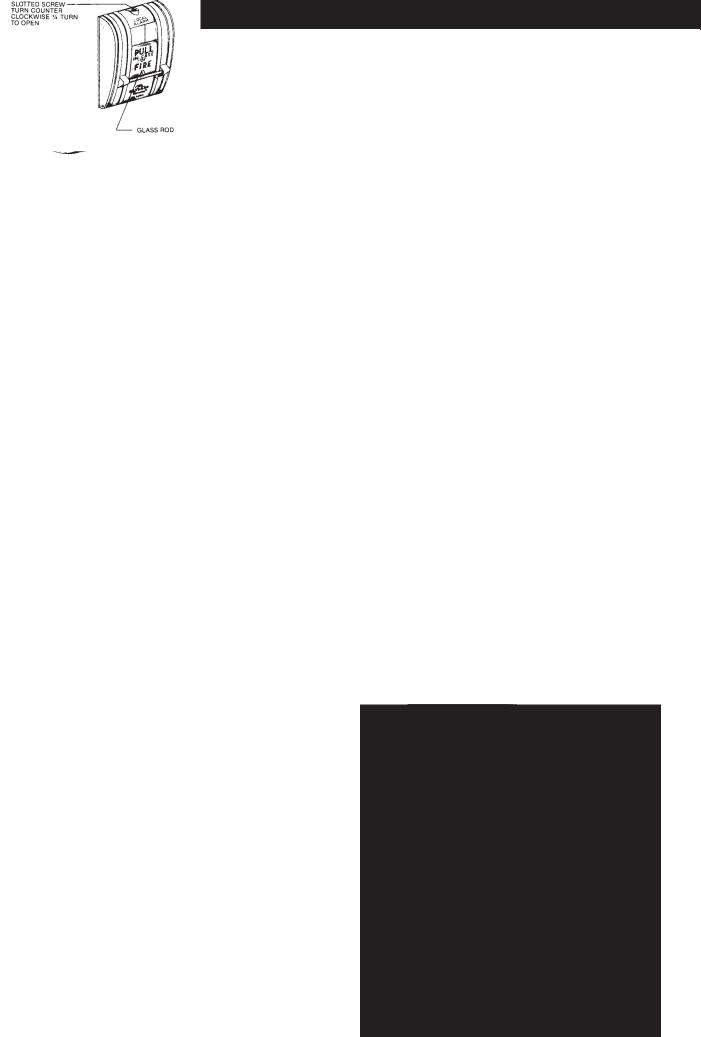
C-ESP FIRE MODE
EXTERNALFIREMODE
An External Fire Mode is activated by the Pollution Control Units or Ventilator’s Fire Suppression (Duct, Plenum, Surface/Appliance) system’s microswitch or contacts and/or an optional break glass fire switch (see Figure 5). Terminals 4 & FS are used for the External Fire Mode, refer to wiring diagram for details. The break glass fire switch, if used, would normally be located at the exit of the kitchen. When the External Fire Mode is activated, the following occurs:
1.The Exhaust Fan comes on immediately if it was off to help remove smoke, heat, etc.
2.The Supply Fan shuts off immediately.
3.The digital display reads “Ext.FireActive” and alternates between “Reset FireSwitch” and “Fan On, Wash On”.
4.A red light on the Command Center flashes.
5.After a 60-second delay, a fire smothering water spray is released into the interior of the C-ESP and the Cap- tive-Aire Ventilators, if so equipped, through the spray nozzles.The 60-second delay allows the C-ESP's and ventilator’s fire suppression system time to put out the fire, before starting the water spray.
Summary of Both Fire Modes at the Same Time
1.Internal Fire Mode (until thermostat temperature drops below 250°F)
2.Cool Down Cycle (for 2 minutes)
3.External Fire Mode (until the External Fire Switch is reset)
TESTING INTERNALFIRE MODE
The internal fire protection system may be tested periodically by pushing and holding for 20 seconds, the “Fire Test Switch” located inside the electrical compartment of the control cabinet. Pushing this switch duplicates thermostatic action. CAUTION: Before pushing the “Fire Test Switch”, check to see if the internal fire protection system is tied to the building alarm system.
TO RESUME NORMAL OPERATION
1.To discontinue the 2 minute cool down cycle at any point during the cycle, push the “Exit” F5 button on the CGPC-6000 Command Center.
2.Push the “Start Fan” F1 button on the Command Center.
If the fire intensifies and the thermostat reaches 250°F, the fire damper would then close on a Captive-Aire Ventilator, if so equipped, and the exhaust fan would shut off. See Internal Fire Mode.
Toresumenormaloperations,openthefireswitchandflipthe toggle switch to the position marked “normal”. Replace the glass rod and close the cover. Push either the “Start Fan” or “Start Wash” button.
SURFACEFIREPROTECTION
The National Fire Protection Association, NFPA-96 document requires fire extinguishing equipment over all grease producing cooking equipment such as griddles, ranges, fryers, broilers, and woks. In addition, the system must protect the interior of the ventilator and the exhaust duct.
The most common fire system is a wet chemical type. In the event of a fire this system would normally be activated and discharged prior to the ventilator’s internal fire protection. If the fire is unusually severe or the surface fire protection system malfunctions, the ventilator’s internal fire protection system would activate, thus providing a second level of defense. These systems may be intertied with the ventilator control cabinet to activate the External Fire Mode.
BREAK GLASS FIRE SWITCH |
|
|
|
|
|
C-1357A SERIES |
FIREMODESUMMARY: |
|
|
||
|
|
|
|||
INTERNAL&EXTERNALFIREMODESATTHESAMETIME |
Note: The Damper Position applies to a Captive-Aire Ventila- |
||||
It is possible that both the Internal and External Fire modes |
tor, if so equipped. |
|
|
||
can be activated at the same time. If this occurs, the Internal |
|
|
|
|
|
Fire Mode will override the External Fire mode until the |
|
|
|
|
|
thermostat(s) cool below 250°F. At this point the Cool Down |
|
|
|
|
|
|
INTERNAL |
COOL DOWN CYCLE |
EXTERNAL |
||
Cycle will start counting down for 2 minutes. After the Cool |
|
(for Internal Fire |
|||
Down Cycle, the External Fire mode will start. |
|
FIRE |
Mode only!) |
FIRE |
|
Special Note: If the control is in the Cool Down Cycle when |
Exhaust Fan |
OFF |
OFF |
ON |
|
Supply Fan |
OFF |
OFF |
OFF |
||
the External Fire mode is activated, the Cool Down Cycle |
|||||
Damper Position |
FIRE |
EXHAUST |
EXHAUST |
||
will finish counting down for 2 minutes, before switching to |
|
|
|
|
|
Water Spray |
ON |
ON |
ON |
||
the External Fire Mode. |
|
|
|
|
|
18 |
|
|
|
|
|
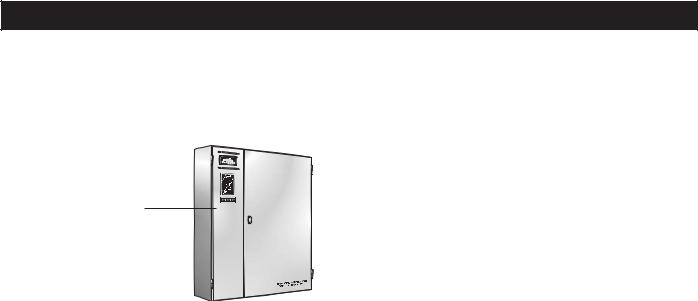
DAILY OPERATION
DAILY OPERATION
All functions of the Captive-Aire Ventilator and C-ESP Unit, such as starting the exhaust fan, starting the wash cycle, etc., are controlled by the Command Center located on the control cabinet. Refer to Pages 21 through 25 for detailed instructions on the operation of the Command Center.
COMMAND CENTER
MODELCGPC-6000SERIES
5.After the damper in the ventilator closes to the wash position, the hot detergent injected water sprays come on to wash away the grease collected during the day's operation. The wash cycle stays on for the length of time programmed in the Command Center. The length of the wash cycle may be set between 3 and 9 minutes.Typical settings for the Captive-Aire Ventilator are 3 minutes for light-duty equipment, 5 minutes for me- dium-duty equipment and 9 minutes for heavy-duty equipment. The typical setting for the C-ESP unit is 5 minutes. Refer to page 20 for details on setting the length of the wash.
|
6.During a Ventilator wash, the digital display reads "Hood |
||
CONTROL CABINET |
Wash, Wash #1 xxx seconds." xxx is the countdown in |
||
MODEL CGPC-6000-ESP SERIES |
seconds until this portion of the wash is completed. |
||
|
7.During an ESP wash, the digital display reads: |
||
Starting the Exhaust Fan |
"ESP Wash 1, Wash #2 xxx seconds" |
||
To start the exhaust fan and C-ESP Unit push the “Start Fan” |
"Hot Water Heating, Wash #2 xxx seconds" |
||
button on the Command Center. If the Command Center is pro- |
"ESP Wash 2, Wash #2 xxx seconds." |
||
grammed to start the fan automatically, then the start button |
"Hot Water Heating, Wash #2 xxx seconds" |
||
does not need to be pushed. It is important to start the exhaust |
"ESP Rinse, Wash #2 xxx seconds" |
||
fan before turning on the cooking equipment. |
xxx is the countdown in seconds until this portion of the |
||
When the exhaust fan is activated the following occurs: |
wash is completed. |
|
|
8.The digital display now reads "Fan Off 12:00" (current time) |
|||
1.The damper on Captive-Aire's Ventilator begins opening to |
|||
and Start Fan>F1. |
|
||
the exhaust position. (if applicable) |
|
||
After the wash cycle is |
completed, wipe the exposed front |
||
2.A green light on the Command Center illuminates. |
|||
surface of the damper at the air inlet slot, as well as other |
|||
3.The supply fan comes on. |
exposed exterior surfaces. |
||
4.The digital display reads "Starting Fan & Damper Opening" |
In very heavy cooking operations it may be necessary to |
||
for approximately 5 seconds. Then the digital display reads |
wash the equipment more than once a day. This can be |
||
"Starting Fan, xx Seconds to Fan On". xx is the coundown |
done manually by pushing the “Start Wash” button. |
||
in seconds until the exhaust fan comes on. |
NOTE: For proper operation of the wash system there must |
||
5. After the damper fully opens (elapsed time approximately |
be adequate water pressure and temperature.There is a pres- |
||
45 seconds) the unit exhaust fan starts. |
sure/temperature gauge inside the control cabinet. |
||
6.The digital display then reads "Fan On 12:00" (current |
Water Pressure |
60 psi min. - 80 psi max. |
|
time) and "Start Wash> F2". |
Water temperature 160°F min. - 180°F max. |
||
|
|||
7. The cell status light(s) will come on indicating that the |
NOTE: Some control cabinets are equipped with a low de- |
||
ESP cells are operating. |
|||
tergent switch. If so equipped, the green light will flash if the |
|||
Stopping the Exhaust Fan and Starting the Wash Cycle |
detergent tank is empty or if the detergent pump is malfunc- |
||
CAUTION: The cooking equipment must be shut off prior |
tioning and detergent is not pumping. The digital display reads |
||
to shutting off the exhaust fan. Failure to do this will cause |
"Low Detergent" and the text alternates from "Fill Tank" and |
||
excessive heat buildup and could cause the surface fire |
"Check Pump". If the detergent tank is filled with water the |
||
protection system to discharge. |
detergent switch will activate as if there is no detergent. |
||
To start the wash cycle push the “Start Wash” button on the |
NOTE: The wash system is designed to remove daily accu- |
||
Command Center. If the Command Center is programmed to start |
mulations of grease within the equipment. If the equipment |
||
the wash automatically, then the start button does not need to be |
is not washed a minimum of once during a cooking day, a |
||
pushed. When the wash cycle is activated the following occurs: |
grease buildup could accumulate which the wash system |
||
1.The exhaust and supply fans shut off. |
cannot remove. If this occurs, it is recommended that the |
||
equipment be put through several wash cycles by pushing |
|||
2. The ESP cells shut off. |
|||
the “Start Wash” button on the Command Center. If this |
|||
3.The damper begins closing forward to the wash position. |
does not remove the grease, it will be necessary to remove |
||
This action takes approximately 45 seconds. |
the grease manually by using a scraping tool, such as a |
||
4.The digital display reads "Starting Wash, Damper Closing" |
putty knife, or retain the services of a commercial hood clean- |
||
ing service to steam clean or pressure wash the system. |
|||
for approximately 45 seconds, then the digital display reads |
|||
WARNING: Some commercial hood cleaning services blow a fire |
|||
"Starting Wash, Wash On in xx seconds". xx is the count- |
|||
down in seconds to until the wash starts. |
retardantchemicalintohoodandductsystems.Fireretardantchemi- |
||
|
cals should never be applied to any portion of The Captive-Aire |
||
19 Ventilator or ESP unit. If retardant is applied, it must be removed.

DAILY OPERATION
Ventilator wash
The length of the ventilator wash is determined primarily by the cooking equipment involved. Set the wash length from 3 – 9 minutes for light, medium or heavy duty equipment as shown on the Recommended Ventilator Wash Time Chart on this page. Adequate cleaning of the Ventilator is dependent upon water pressure, water temperature, grease accumulation and hours of operation. It may be necessary to increase the wash cycle time above recommendations depending upon these conditions.
C-ESP wash
The length of wash cycle time for the C-ESP Unit is normally set for 5 minutes as shown on the "Wash Cycle Sequence Charts". Set length of ESP washes to 5 minutes.
Delay
The "Wash Delay" is used to set the delay time between each wash. A delay may be necessary to allow the hot water system to recover. The Wash Delay may be set from 1 – 99 minutes as required.
Rinse cycle
A rinse cycle is a hot water wash only (no detergent), and occurs at various times during the wash cycle as shown on the "Wash Cycle Sequence Charts". The rinse cycle time is 3 minutes.
RECOMMENDED VENTILATOR WASH TIME CHART
|
TYPE OF COOKING |
RECOMMENDED WASH |
|
EQUIPMENT |
TIMES (MINUTES) |
|
LIGHT DUTY ........................................... |
3 |
|
Ovens, steamers, and kettles |
|
|
MEDIUM DUTY ....................................... |
5 |
|
Braising pans/Tilting skillets, fryers, |
|
|
griddles, grooved griddles, open burner |
|
|
ranges, hot top ranges, and |
|
|
conveyor ovens |
|
|
HEAVY DUTY .......................................... |
9 |
|
Gas and electric char broilers, upright |
|
|
broilers, woks and conveyor broilers, |
|
|
Solid fuel broilers |
|
|
WASH CYCLE SEQUENCE CHARTS |
|
|
All ESP Washes include the following steps: |
|
1. |
ESP Wash 1 |
(3-9 minutes) |
2. |
Delay |
(1-99 minutes) |
3. |
ESP Wash 2 |
(3-9 minutes) |
4. |
Delay |
(1-99 minutes) |
5. |
ESP Rinse |
(3 minutes) |
NOTES:
*ESP Wash 2 length = ESP Wash 1 length (always)
*ESP Rinse length = 3 minutes (always)
*Please note ALL “Delay” times are the same
All Hood Washes include the following:
1. Hood Wash (3-9 minutes)
Typical Wash Cycle for a Single Pass (1ESP) unit with 1 Wash manifold:
1. |
ESP Wash 1 |
(5 minutes) |
2. |
Delay |
(1 minute) |
3. |
ESP Wash 2 |
(5 minutes) |
4. |
Delay |
(1 minute) |
5. |
ESP Rinse |
(3 minutes) |
Total Elapsed Time: |
15 minutes |
|
Typical Wash Cycle for a Single Pass (1ESP) unit with 2 Wash manifolds (DW):
Wash Manifold #1 |
|
|
1. |
ESP Wash 1 |
(5 minutes) |
2. |
Delay |
(1 minute) |
3. |
ESP Wash 2 |
(5 minutes) |
4. |
Delay |
(1 minute) |
5. |
ESP Rinse |
(3 minutes) |
6. |
Delay |
(1 minute) |
Wash Manifold #2 |
|
|
7. |
ESP Wash 1 |
(5 minutes) |
8. |
Delay |
(1 minute) |
9. |
ESP Wash 2 |
(5 minutes) |
10. Delay |
(1 minute) |
|
11. ESP Rinse |
(3 minutes) |
|
Total Elapsed Time: |
31 minutes |
|
20
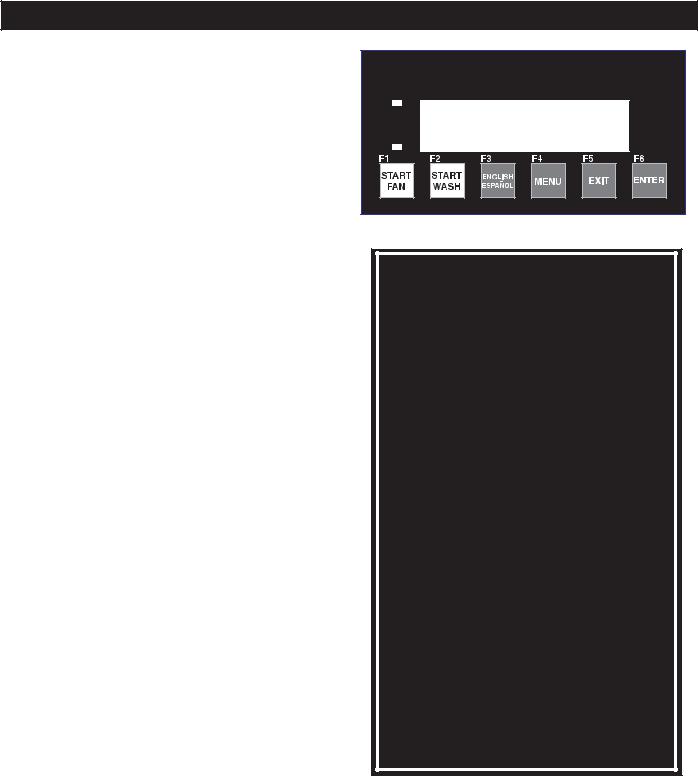
MODEL CGPC-6000-ESP SERIES COMMAND CENTER - INSTRUCTIONS
General Description:
The CGPC-6000-ESP Command Center is designed to start and stop the exhaust fan and wash up to 5 groups of ventilators and a C-ESP unit in sequence with a delay period between each wash. A sequence wash may be necessary if the building’s hot water system is not capable of supplying the required volume of water at one given time.
The exhaust fan and wash sequence may be started Manually by pushing the “Start Fan” or “Start Wash” buttons, or may be programmed for Automatic operation.
Programmed operations may include:
1.Starting the exhaust fan once within a 24-hour period.
2.Stopping the exhaust fan and starting the wash cycle sequence once within a 24-hour period.
3.Programming the length of the wash cycles and delay periods between the wash cycles. The maximum length of a wash cycle is 9 minutes. The maximum length of the delay period is 99 minutes.
4.Skipping a day so the exhaust fan and wash cycle do not operate for holidays or specific days within a 7-day week when the kitchen is not operating.
The CGPC-6000-ESP Command Center provides information and programming for various functions by accessing nine different menu catagories. An overview of the nine menu items are as follows:
1.Cycle Type: Toggles each wash solenoid between a Hood wash and an ESP wash. Preset at factory and protected by a password.
2.Detergent: Displays Toll-Free Number to order detergent: 800-286-2010.
3.Wash Length: Sets length of each wash cycle from 3 to 9 minutes.
4.Delay Time (for sequence wash units only): Sets delay between washes from 1 minute to 99 minutes.
5.Set Clock: Day, hour and minutes.
6.AutoMode [M or A]: Sets the CGPC-6000-ESP to Manual orAutomatic modes. InAutomatic mode, the CGPC-6000- ESP will start the Fan and Wash at the preset times that were set using the Set Wash Times option.
A = Automatic / M = Manual
Also allows individual days (Mon, Tues., etc.) to be set ON or OFF when Automatic mode is selected.
7.Set Wash Times: Sets Start Times for Automatic start of Fan and wash when CGPC-6000-ESP is set to Automatic mode.
8.Wash Test: Runs through a complete Wash Cycle with decreased times.
Damper Closing Time = 10 sec. Wash Times = 10 sec.
Water Heating Time = 10 sec.
COMMAND CENTER |
MODEL CGPC-6000 COMMAND CENTER
OPERATING INSTRUCTIONS
1.Push "Start Fan" before turning on cooking equipment. Note: There is a 45 second delay after pushing the button before the fan starts to allow the damper to open to the
"Exhaust" position.
2.At the end of the day, or whenever cooking is completed, push "Start Wash". This will turn off the exhaust fan and
close the damper forward to the "Wash" position.
Note: There is a 45 second delay after pushing the button before the wash cycle starts, to allow the damper, if so equipped, to close to the "Wash" position. After closing, the timed wash cycle begins. Damper stays closed until "Start
Fan" is pushed. Note: 24 hour kitchens must push "Start
Wash" at least once a day, or as needed for proper cleaning.
3.To set the length of the time for the wash cycle, press
"Menu", then press [F1] until "Wash Length" appears on the display. Follow the instructions on the display to edit the length of washes as necessary.
Note: Refer to the programming instructions on the inside of this cabinet for more information on programming the CGPC-6000 Command Center.
L O W D E T E R G E N T
The green light will flash and "Low Detergent" will be displayed on the CGPC-6000 Command Center indicating the detergent is low.
FIRE CONDITION
1.A flashing red light and the message "Ext. Fire Active" indicates the control is in an External Fire Mode - exhaust
fan on, damper open, and water wash nozzles on.
2.A continuous red light and the message "Fire In Hood" indicates the control is in an Internal Fire Mode - exhaust fan off, damper closed, and water wash nozzles on.
CGPC-6000-ESPCOMMANDCENTER
Exits menu when finished.
9. Number of Washes: Preset at factory and protected with a password.
Allows the number of washes to be changed from 1 to 13 (S1 to S13).
21

MODEL CGPC-6000-ESP SERIES COMMAND CENTER - INSTRUCTIONS
Spanish (Español) Instructions:
The CGPC-6000-ESP Command Center has the ability to display its commands and messages in either English or Spanish (Español).
Press the "ENGLISH / ESPAÑOL" [F3] button to toggle the language displayed from English to Spanish (Español) or from Spanish (Español) to English.
NOTE: All messages displayed by pressing the "MENU" [F4] button only appear in English. They will not appear in Spanish (Español).
Using the Menu:
To Enter the Menu, press the MENU button [F4]. To navigate the Menu:
•Press [F1] to go to the Next menu item
•Press [F2] to go to the Previous menu item
•Press [F5], the EXIT button to exit the Menu
•Press [F6], the ENTER button to select a Menu item
1.Cycle Type
•Pressing [F6] [ENTER] will prompt for a password. It is not necessary to change these settings. They are preset at the factory.
2.Detergent
•Pressing [F6] [ENTER] will prompt for a password. It is not necessary to change these settings. They are present at the factory.
3.Wash Length
•Press [F6] [ENTER] to display the Length of Wash #1
•Press [F3] to Increase the Wash Time up to 9 Minutes (Maximum)
•Press [F4] to Decrease the Wash Time down to 3 Minutes (Minimum)
•Press [F1] to adjust the Length of Wash #2 (if applicable)
•Press [F5] [EXIT] to return to the menu
•Note: Press [F1] to advance through all washes (ex.) “-S2” has 2 washes)
4.Delay Time
•Press [F6] [ENTER] to display the Delay Time between washes (Not used if there is only one wash)
•Press [F3] to Increase the Delay Time up to 99 Minutes (Maximum)
•Press [F4] to Decrease the Delay Time down to 1 Minute (Minimum)
•Press [F5] [EXIT] to return to the menu
5.Set Clock
•Press [F6] [ENTER] to display the current Day of the Week (1=Sunday)
•Press [F3] to change to the next Day of the Week (1=Sun, 2=Mon, 3=Tues, etc.), keep pressing [F3] to cycle around if necessary
•Press [F1] to go to the current Hour
•Press [F3] to increase the Hour, keep pressing [F3] to cycle around if necessary
•Press [F1] to go to the current Minute
•Press [F3] to increase the Minute, keep pressing [F3] to cycle around if necessary
•Press [F5] [EXIT] to return to the menu
6.AutoMode [A or M]
• Used to select [M]anual or [A]utomatic mode. If [A] is displayed, the CGPC-6000-ESP is set to operate in Automatic mode. If [M] is displayed, the CGPC-6000-ESP is set to operate in Manual mode.
•Press [F6] [ENTER] to display the “Set Mode” screen
•Press [F6] [ENTER] again to toggle between [M]anual or [A]utomatic mode
Setting Which Days of the Week to Run:
• Press [F1] to select which days to run the CGPC-6000- ESP in Automatic mode
• “Sun ON” or “Sun OFF” will display
•Press [F3] to set a day to “ON”. Set a day to “ON” in order for the CGPC-6000-ESP to run on that day
•Press [F4] to set a day to “OFF”. Set a day to “OFF” in order for the CGPC-6000-ESP NOT to run on that day
•Press [F1] to cycle through each day of the week [Sun – Sat.]
•Press [F5] [EXIT] to return to the menu
7.Set WashTimes
•Only used when CGPC-6000-ESP is set to Automatic mode
•Press [F6] [ENTER] to display the Start time for the Fan on Sunday (Sun. Fan)
•Press [F3] to increase the Hour
•Press [F4] to increase the Minutes
•Press [F1] to go to the Start time for the Wash on Sunday (Sun.Wash)
•Set the time, using the same method described above
•Press [F1] to cycle through for each day of the week, for the Start Times for the Fan and Wash
•Press [F5] [EXIT] to return to the menu
8.Wash Test
•Press [F6] [ENTER] to run the CGPC-6000-ESP through a complete Wash cycle with decreased times
•After the Wash Test is complete, the CGPC-6000-ESP will return to the Fan Off mode
9.Number of Washes
•Pressing [F6] [ENTER] will prompt for a password.
It is not necessary to change this value. It is preset at the Factory.
22
